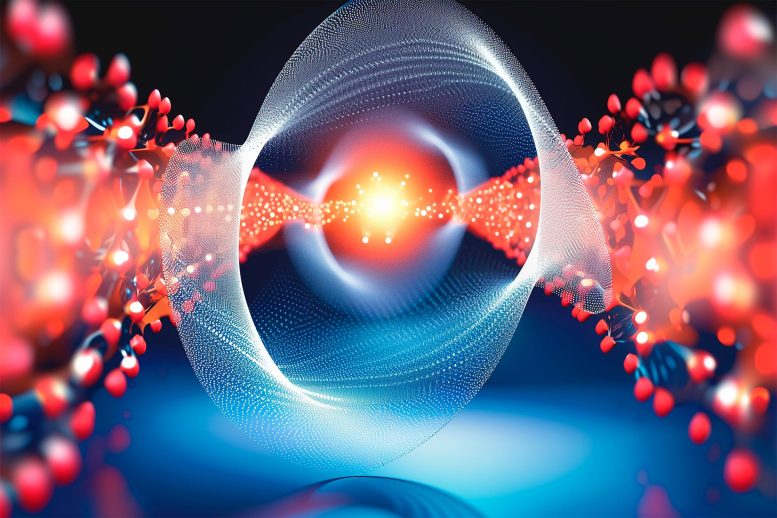
In a pivotal discovery, researchers have identified a fundamental link between quantum entanglement and topology. This breakthrough enhances our comprehension of quantum mechanics and paves the way for innovative approaches in quantum technology, potentially revolutionizing quantum computing and communication fields. Credit: SciTechDaily.com
This experimental milestone allows for the preservation of quantum information even when entanglement is fragile.
For the first time, researchers from the Structured Light Laboratory (School of Physics) at the University of the Witwatersrand in South Africa, led by Professor Andrew Forbes, in collaboration with string theorist Robert de Mello Koch from Huzhou University in China (previously from Wits University), have demonstrated the remarkable ability to perturb pairs of spatially separated yet interconnected quantum entangled particles without altering their shared properties.
“We achieved this experimental milestone by entangling two identical photons and customizing their shared wave-function in such a way that their topology or structure becomes apparent only when the photons are treated as a unified entity,” explains lead author, Pedro Ornelas, an MSc student in the structured light laboratory.
This connection between the photons was established through quantum entanglement, often referred to as ‘spooky action at a distance’, enabling particles to influence each other’s measurement outcomes even when separated by significant distances. The research was published in Nature Photonics on January 8, 2024.
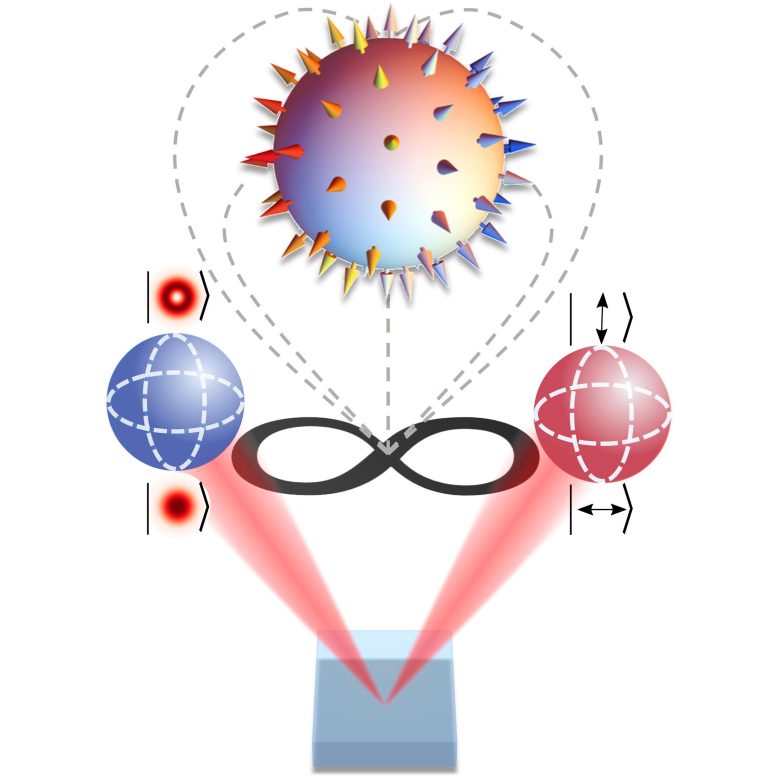
Conceptual illustration of the entangled Skyrmion topology. Each photon contributes to the emerging topology that only exists as a combined entity of the two photons. Credit: Wits University
Topology in Quantum Entanglement
The role of topology and its ability to preserve properties, in this work, can be likened to how a coffee mug can be reshaped into the form of a doughnut; despite the changes in appearance and shape during the transformation, a singular hole – a topological characteristic – remains constant and unaltered. In this way, the two objects are topologically equivalent. “The entanglement between our photons is malleable, like clay in a potter’s hands, but during the molding process, some features are retained,” explains Forbes.
The nature of the topology investigated here, termed Skyrmion topology, was initially explored by Tony Skyrme in the 1980s as field configurations displaying particle-like characteristics. In this context, topology refers to a global property of the fields, akin to a piece of fabric (the wave function) whose texture (the topology) remains unchanged regardless of the direction in which it is pushed.
These concepts have since been realized in modern magnetic materials, liquid crystals, and even as optical analogs using classical laser beams. In the realm of condensed matter physics, skyrmions are highly regarded for their stability and noise resistance, leading to groundbreaking advancements in high-density data storage devices. “We aspire to see a similar transformative impact with our quantum-entangled skyrmions,” says Forbes.
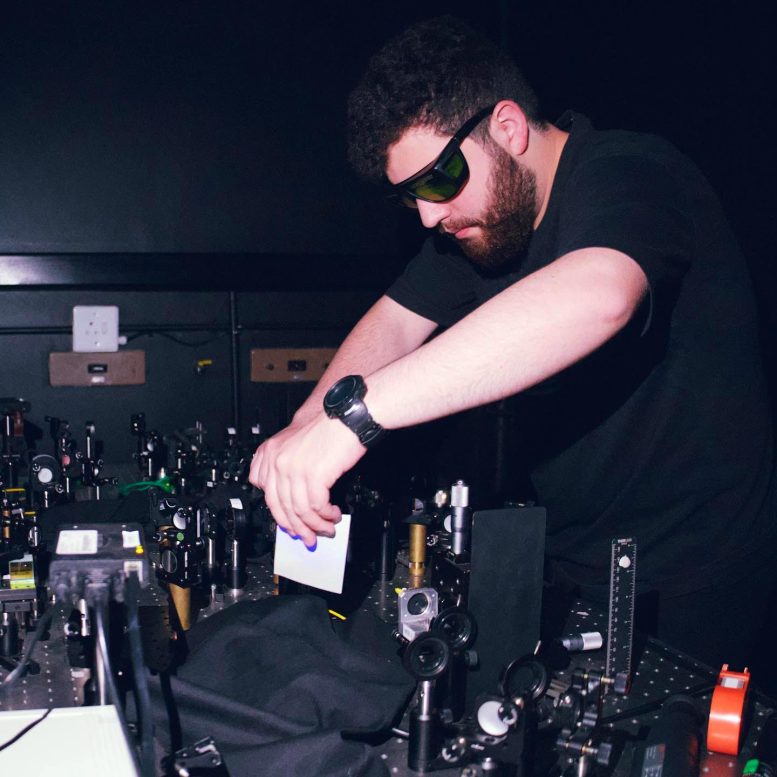
Pedro Ornelas, an M.Sc student at the Wits Structured Light Laboratory in the Wits School of Physics is leading the experiment. Credit: Wits University
Paradigm Shift in Quantum Research
Previous research depicted these Skyrmions as localized at a single location. “Our work presents a paradigm shift: the topology that has traditionally been thought to exist in a single and local configuration is now nonlocal or shared between spatially separated entities,” says Ornelas.
Expanding on this concept, the researchers utilize topology as a framework to classify or distinguish entangled states. They envisage that “this fresh perspective can serve as a labeling system for entangled states, akin to an alphabet!” says Dr. Isaac Nape, a co-investigator.
“Similar to how spheres, doughnuts, and handcuffs are distinguished by the number of holes they contain, our quantum skyrmions can be differentiated by their topological aspects in the same fashion,” says Nape. The team hopes that this might become a powerful tool that paves the way for new quantum communication protocols that use topology as an alphabet for quantum information processing across entanglement-based channels.
Implications for Quantum Communication
The findings reported in the article are crucial because researchers have grappled for decades with developing techniques to preserve entangled states. The fact that topology remains intact even as entanglement decays suggests a potentially new encoding mechanism that utilizes entanglement, even in scenarios with minimal entanglement where traditional encoding protocols would fail.
“We will focus our research efforts on defining these new protocols and expanding the landscape of topological nonlocal quantum states,” says Forbes.
Reference: “Non-local skyrmions as topologically resilient quantum entangled states of light” by Pedro Ornelas, Isaac Nape, Robert de Mello Koch and Andrew Forbes, 8 January 2024, Nature Photonics.
DOI: 10.1038/s41566-023-01360-4

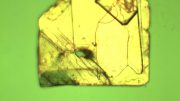



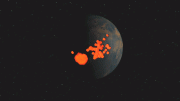



In a pivotal discovery, researchers have identified a fundamental link between quantum entanglement and topology.
According to topological vortex gravitational field theory, quantum gravity comes from the spin of topological vortices. Quantum entanglement is closely related to the spacetime entanglement and gravity entanglement of topological vortices.
May I express an idea in regard to Quantum entanglement? It is expressed that protons can be entangled large distances away. Could it be that they are right next to each other in regards to time being a constraint. Is it possible that if allot of energy was poured in or some variable/ variables we are not looking at brings the past, present, and future of the protons close to each other secondary to the time constraint and or other variables that we are not knowledgeable about. We talk about universes that are next to each other. Could this be one of those variables?
According to the theory of topological vortex gravitational field, the synchronization effect of topological vortices is ubiquitous, whether in the past, present, or future.
In theory, each topological vortex is a variable.
This really hits hard me with my hypothisis. I came up with this in 2018. And it’s gotten more “earth friendly” concepts behind it.
No two protons are absolutely identical, let alone their past, present, and future.
Exactly 💙
Thank you.
This reads as if they have found a language tool.
Possibly when the spokes defrost in the ring orbit of Saturn 🪐 that could be an element. It’s coming up Also. May 6th 2025